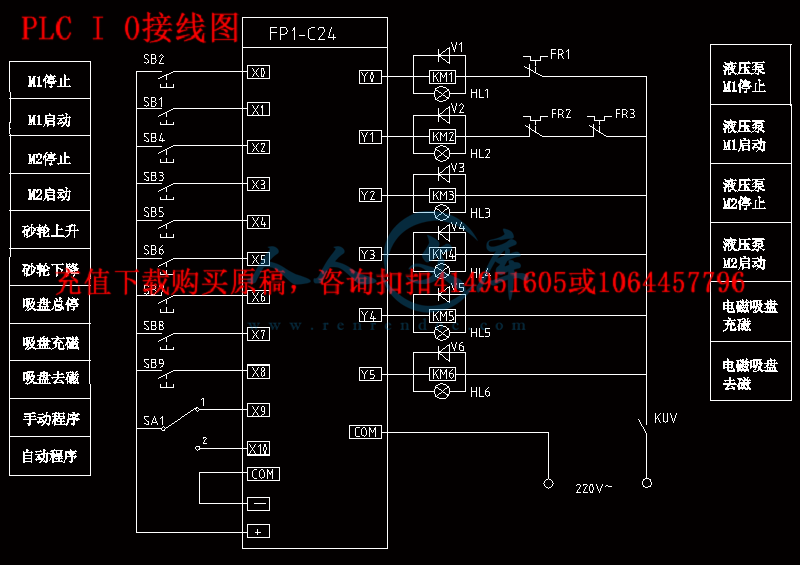摘 要
本文介绍了用可编程序控制器来对平面磨床M7120控制系统进行现代化改造。改造后的磨床工作安全可靠,系统运行情况良好,磨削精度更高;利用PLC控制磨床运行,实现了磨床启动、停止、故障停止的功能,并且有手动控制和自动控制两种控制方式,可根据运行要求灵活切换磨床的控制方式;提供过载,轻载,断相和电压不平衡保护;现场显示运行状态,实现智能化监控。实现了磨床运行的自动化且使原机床控制大大的简单化,并且维修方便,易于检查,工作效率更高。
关键词:PLC,平面磨床,改造
Based on PLC Surface Grinding Machine Automatic Control System's Transformation
Abstract
This paper describes that use PLC to modernize the surface grinder machine M7120’s control systems. After the transformation of the grinder , the system is work safety and reliability ,running well as well as higher precision grinding .Using PLC control grinding machine running, and the grinder start, stop, failure to stop the function, and the manual control and automatic control , Under the operational requirements switches the way of the Control
method flexibly ; provide over-load, light-load, loss of phase and the imbalance protects of voltage, demonstrate the state of the running scene and intelligent control. Grinder has realized the automation working and the control of the original machine greatly simplified and easy maintenance, easy to check, work more efficient.
Key words: Progammable Logic Controller, Surface Grinder Machine, Transformation
目 录
1 绪论1
2 设计要求2
3 磨床的概述2
3.1 磨床介绍2
3.2 世界平面磨床发展趋势2
3.2.1现代平面磨床的主要特点2
3.2.2发展呈现四大变化3
3.2.3根本在于设计创新4
4 可编程序控制器(PLC)的概况4
4.1 PLC的系统结构和基本工作原理4
4.1.1 PLC的系统结构4
4.1.2 PLC的基本工作原理5
4.1.3 PLC的主要功能6
4.2 PLC的应用设计步骤7
4.3 PLC的选型原则8
4.3.1 松下电工可编程序控制器产品---FP1-C24介绍9
5 系统的总体设计11
5.1 改造平面磨床的步骤11
5.1.1 改造方案的确定11
5.1.2 改造的技术准备11
5.1.3 改造的实施12
5.2 用PLC改造继电-接触式控制系统的步骤13
5.3 控制线路控制改造要求14
5.4 原设备电器的工作原理14
5.4.1 平面磨床主要结构和运动形式14
5.4.2 电气控制线路分析15
5.5 分析控制对象,进行系统的硬件设计19
5.6 系统的软件设计20
6 磨床改造后的调试22
7 结束语23
致谢23
参考文献23
附录25
1 绪论
现代工业生产中,中、小批量零件的生产占产品数量的比例越来越高,零件的复杂性和精度要求迅速提高,传统的普通磨床已经越来越难以适应现代化生产的要求,制造业的竞争已从早期降低劳动力成本、产品成本,提高企业整体效率和质量的竟争,发展到全面满足顾客要求、积极开发新产品的竟争,将面临知识——技术——产品的更新周期越来越短,产品批量越来越小,而对质量、性能的要求更高,同时社会对环境保护、绿色制造的意识不断加强。因此敏捷先进的制造技术将成为企业赢得竟争和生存、发展的主要手段。计算机信息技术和制造自动化技术的结合越来越紧密,作为自动化柔性生产重要基础的数控机床在生产机床中所占比例将越来越多。但新机床购置费用高,且生产准备周期长。因此对原有机床的现代化改造显得尤为重要。而用PLC改造老机床有很多优点:⑴节省资金,减少投资额,交货期短 机床的PLC改造,可大大减少资金的投入,同购置新机床相比,一般可节省60 % ~80 % 的费用,改造费用低。特别是大型、特殊设备尤为明显。一般大型机床改造,只需花新机床购置费的1/3。即使将原机床的结构进行彻底改造升级,也只需花费购买新机床60 % 的价格。⑵性能稳定可靠 因原机床各基础件经过长期时效,几乎不会产生应力变形而影响精度,且各部件已经长期磨合,使改造后的机床性能稳定可靠,质量好,可作为新设备继续长期使用。⑶可充分体现企业自身的意愿 企业与改造人员可依照实际需要和机床长期使用的情况,在改造中提出对机床性能、操作与维修等方面的改进意见,有权选择机械零部件、数控系统、电器设备等的规格、型号、性能等。可根据技术革新的发展速度,及时地提高生产设备的自动化水平和效率,提高设备质量和档次,将机床改造成具有当今水平的设备。⑷更有利于使用和维护 由于改造前机床已使用多年,操作者对机床的特性早已了解,在操作使用和维修方面培训时间短、见效快。改造的机床一经安装好,就可实现全负荷运转。⑸可以采用最新的控制技术,提高生产效率。可根据技术革新的发展速度,及时地提高生产设备的自动化水平和效率,提高设备质量和档次,将旧机床改成当今水平的机床。机床经改造后,即可实现加工的自动化,效率可比传统机床提高3~7倍。对复杂零件而言,难度越高,功效提高得越多。且可以不用或少用工装,不仅节约了费用,而且可以缩短生产准备周期。提高产品质量,降低废品率,零件的加工精度高,尺寸分散度小,使装配方便灵活。因此,继电器本身固有的缺陷,给床的安全和经济运行带来了不利影响,用PLC对磨床的继电器式控制系统进行改造已是大势所趋[1] 。所以我们就以平面磨床改造来介绍一下。






 川公网安备: 51019002004831号
川公网安备: 51019002004831号